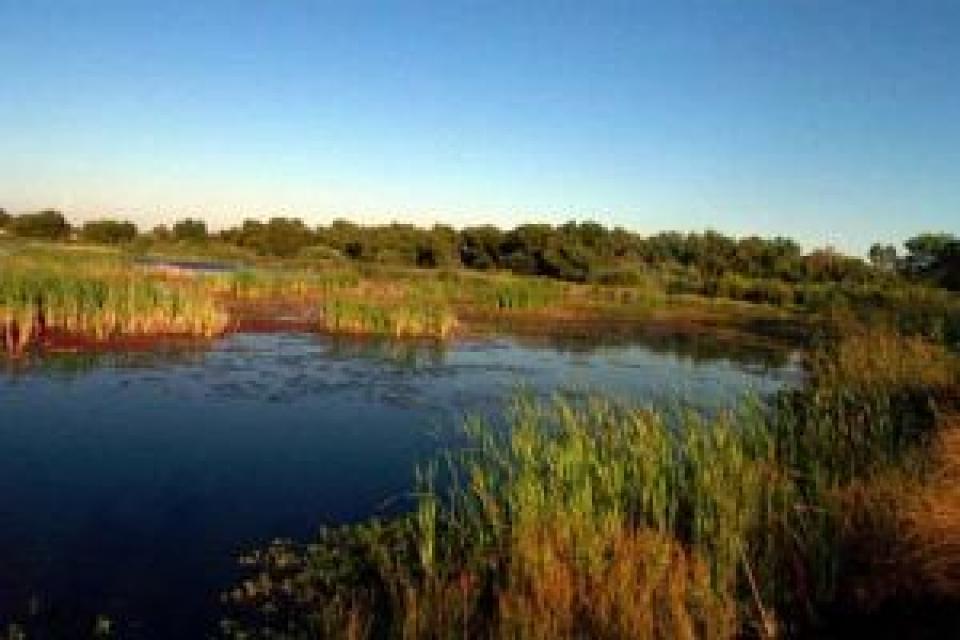Cosumnes River
Northern California’s Cosumnes River is the only river on the
western side of the Sierra
Nevada without major dams. The river flows about 52.5 miles
from its headwaters at the 7,350-foot into the Central
Valley, merging with Mokelumne River in the Sacramento-San Joaquin
Delta at Mokelumne City, originally formed in 1850 that now
is a California Historical Landmark 26 miles south of
Sacramento.
The river endures seasonal overbank flooding that was once a typical occurrence along rivers in California’s Central Valley. The flooding fosters vegetation growth in riparian and floodplain habitats, which in turn supports a wide range of wildlife.
The Cosumnes River is believed to be named combining the Miwok word “kosum” meaning “salmon” and the “-umne” suffix meaning “people of”.
The Different Forks
 The Cosumnes River features three forks – north,
middle and south – that cut through canyons in El Dorado and
Amador counties and converge east of Highway 49.
The Cosumnes River features three forks – north,
middle and south – that cut through canyons in El Dorado and
Amador counties and converge east of Highway 49.
- The 40-mile long North Fork begins at the Singleton Springs in El Dorado County (about 10 miles southwest of Kirkwood ski resort) and flows west, receiving its largest tributary, Camp Creek, at Somerset. Below Camp Creek the river flows through the granite narrows of the Cosumnes River Gorge and joins the Middle Fork near Enterprise.
- The 44.5-mile long Middle Fork also starts in El Dorado County and basically parallels the North Fork. From the headwaters, the river flows through a canyon, collecting Dogtown Creek at Omo Ranch. From there, the water flows through a valley past Outingdale.
- The 20-mile long South Fork flows northwest along the El Dorado/Amador County line before connecting with the Middle Fork. Not far from there, all forks combine, and the river continues to flow west through the Sierra foothills, the historic mining site Michigan Bar and then into southern Sacramento County.
The river then flows west through the Sacramento suburb Rancho Murrieta, through agricultural land and past Sloughhouse. It goes under Highway 99 near Elk Grove and into the Cosumnes River Preserve, which include some of the largest wetlands and riparian areas in the Central Valley.
It then enters the Sacramento–San Joaquin River Delta near Mokelumne City, turning west once more to join the Mokelumne on the border of Sacramento County and San Joaquin County.
Diversions
Some water is diverted from the North Fork at Camp Creek and from Sly Park Creek to be used for irrigation in the Camino area.
Sly Park creek, a tributary of the Middle Fork, provides water for Sly Park Dam, near Pollock Pines. The creek creates 41,000-acre-foot Jenkinson Lake. The dam and reservoir are part of the federal Central Valley Project.
Restoration
 Federal and state agencies, university and nonprofit
organizations have teamed up to restore portions of the river.
Together they have improved habitat on 500 acres of
floodplain and 600 acres of riparian areas, as well as removed or
improved two fish passage barriers, replaced five stream
crossings and made 7.2 miles of stream made accessible to fish.
Federal and state agencies, university and nonprofit
organizations have teamed up to restore portions of the river.
Together they have improved habitat on 500 acres of
floodplain and 600 acres of riparian areas, as well as removed or
improved two fish passage barriers, replaced five stream
crossings and made 7.2 miles of stream made accessible to fish.
In 2011, the removal of the last river barrier opened up 7.2 more miles of spawning habitat for adult steelhead and fall-run Chinook salmon.
Fish
Like other waters in California, the salmon population has dwindled through the years on the Cosumnes due to, in part, invasive fish species, irrigation diversion structures and pollution from illegal mining activity.
The number of annual fall-run Chinook salmon, which return from June through November and spawn from early October through late December, have dwindled to about half over the past 60 years, according to the California Department of Fish and Wildlife monitoring statistics.
For example, from 1953-1958, an average of 1,800 salmon were counted during the fall run. From 1960-1969, there were an average of 1,500; 1970-1979, an average of 600; 1980-1988, an average of 300; from 2000-2004, an average of 800 salmon. In 2012, the population spiked to 1,071. Yet in 2014, only 373 fish were counted during fall run. See the statistics here.
Cosumnes River Preserve
The Cosumnes River Preserve consists of more than 50,000 acres along the Cosumnes River and is buffered by agricultural lands to provide both floodplains and riparian habitat. Activities include hiking along 11 miles of trails, paddling and nature watching.
The preserve supports more than 250 bird species, more than 40 fish species and about 230 plant species. These include sandhill cranes, egrets and herons, stilts and avocets and many more, including birds that migrate throughout the Pacific Flyway.
Property in the preserved is owned by seven partners — The Nature Conservancy, Bureau of Land Management, California Department of Fish & Wildlife, Sacramento County Regional Parks, Department of Water Resources, Ducks Unlimited, and the California State Lands Commission.
Click here to find out more.








